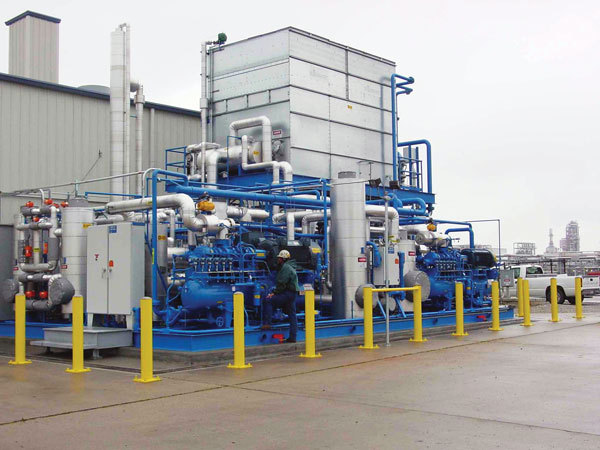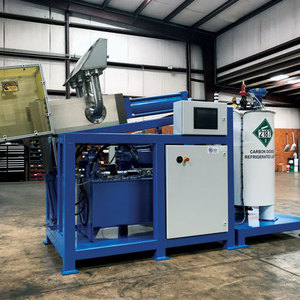The Case for a Credit



PHOTO: CO2 AIR INC.
May 9, 2019
BY Steffen Mueller and Sam Rushing
The role of ethanol-based carbon dioxide is often underappreciated, both as an important source for the nation’s carbon dioxide market and for its carbon-reduction impact. Fermentation CO2 is captured, cleaned and condensed at 49 ethanol plants in the U.S., contributing between 30 and 40 percent of the nation’s total CO2 supply.
Currently, ethanol CO2 is not given a coproduct credit in greenhouse gas (GHG) modeling. The argument is that although the CO2 is captured, it is not being sequesteread and will ultimately be released into the atmosphere. Considering the importance of fermentation CO2 to several industrial and food segments, the life cycle modeling should be transitioning from a waste product to being viewed as a coproduct. And, considering the environmental impact of alternatives, there is an argument to be made that ethanol facilities capturing carbon deserve credit for the difference in emissions between gas cleanup and compression of fermentation CO2 versus alternative CO2 production from dirtier, often fossil, resources.
The importance of the ethanol industry’s fermentation CO2 to the U.S. food supply is significant. Other sources include anhydrous ammonia production at 23 plants, hydrogen sources from 20 refineries, natural geological sources from 19 locations and six miscellaneous sources from other chemical processing facilities. In recent years, the best new CO2 opportunities have almost exclusively been ethanol-based. Food and beverage represent 70 percent of the merchant market for CO2 in most regions. Besides adding carbonation to beverages, the food industry uses CO2 as a refrigerant, accounting for more than 40 percent of CO2 application in many markets. CO2 is also used as a preservative and as a solvent for extraction.
Other industrial uses include a wide range of temperature reduction applications, as a shielding gas for welding and a hardening agent in foundries. CO2 is increasingly being used in closed greenhouses to enhance crop growth, being sequestered in the plants themselves. Another interesting application growing in popularity is the application of CO2 in precast and poured concrete, which enhances the calcium carbonate content in the concrete, thus strengthening the material, and secondly, sequestering the CO2 in the concrete. CO2 is also used in pH reduction of municipal and industrial effluent, often replacing sulfuric acid, resulting in environmentally friendly carbonate and bicarbonate byproducts, rather than harmful sulfates.
Tight Supplies
As a significant source of high-quality CO2, the ethanol industry plays a critically important role, according to executives in the merchant CO2 industry.
“In the U.S., the current supply and demand for merchant CO2 is extremely tight,” says Buddy Collin, principal with Reliant Dry Ice Pacific LLC, a manufacturer and supplier of dry ice from liquid CO2. “It would only take a small misstep to cause enormous hardship within the entire industry. For example, if two or three CO2 plants were idled, due to tariffs or other issues beyond the control of the ethanol plant, the end result would lead to much higher prices, and significant shortages of CO2. If four or five ethanol plants were idled, we’d have major shortages of supply, unaffordable prices, and the inability to supply many industries and customers.”
John Lachs, director of product management and process gases for Praxair, one of the largest CO2 producer-suppliers, says if a sheer loss of ethanol sources occurs—perhaps as a result of policy reducing ethanol in gasoline supplies—that abrupt disruption would create major issues. “A reduction of one-third of the supply, assuming demand remained constant, would result in higher prices to customers competing for the reduced supply,” he says. “As this happens, cost to supply the remaining customers would substantially increase as CO2 is moved from greater distances by both rail and truck. This could also increase prices as the additional costs are passed through to the end users. Certain customers would also have the option to switch to alternative technologies as cost increases make CO2 uneconomical.”
Few affordable alternatives to ethanol and other well-established source types exist, says Sonny Knotts, operations and production manager for Idaho-headquartered Norco Inc., a distributor of liquid CO2 to a wide range of markets. Alternative sources tend to be much more expensive, he says, giving as an example the four- to five-fold cost increase to recover CO2 from flue gas using monoethanolamide-based solvent recovery. “Fermentation-based CO2 sources are an extremely valuable source type in the industry, and critically important to the supply network,” Knotts says. Disruptions would lead to much higher prices and, “depending upon the regions served, due to closed plants, this would represent unaffordable or fully unavailable CO2 product. The economic damage to the food industry, beverage and industrial sectors would be severe.”
Past ethanol downturns resulting in several plants going offline demonstrated what can happen. Scott Vanderburg, CEO of Reliant Holdings Ltd., a producer and supplier of CO2, says closures have sent shock waves through the CO2 industry. “In Arkansas, where huge CO2 demands exist within the poultry processing industry, CO2 buyers have become increasingly tired of shortages precipitated by CO2 plant outages. Their response in the past, and present, is a change in refrigeration technologies.” While not the solution of choice, seeking alternatives often leads to conversion to cryogens such as nitrogen or mechanical refrigeration, he says.
Costly Alternatives
Converting to mechanical refrigeration technologies requires a huge capital investment, and the million-dollar price tag would drive some processors out of business. Liquid nitrogen for cooling and freezing is typically much more expensive than CO2. Trying to replace local sources by trucking or railing CO2 from a distance is also problematic. Not only are supplies tight in most regions, but the transportation cost would be significant—the average cost of delivery in the U.S. has been about $3 per mile.
The U.K. and Mexico experienced catastrophic shortages in 2018. In the U.K., supplies became tight, partly as a result of outages in ethanol production. In Mexico, where the primary sources are hydrocarbon-based, the cost and availability of natural gas for anhydrous ammonia production, among other factors, prompted the closing of CO2 plants. In both countries, CO2 was rationed at times, became totally unavailable, or was sold at exceedingly high prices. In the U.K., there were reported fears that food would not be chilled and processed properly.
Moreover, important environmental considerations come into play. Alternative refrigeration methods relying on nitrogen or mechanical refrigeration using refrigerants and compressors are more carbon intensive than fermentation CO2.
But the treatment of ethanol-based CO2 may be changing. In recent years, the International Sustainability and Carbon Certification organization included a coproduct credit for CO2 capture in the certification of Sweden’s Lantmannen Agroetanol. This is because the European Energy Directive provides for a coproduct credit of “emission savings from CO2 capture and replacement ... limited to emissions avoided through the capture of CO2 of which the carbon originates from biomass and which is used to replace fossil-derived CO2 in production of commercial products and services.” The 14-year-old Landtmannen plant produces 230,000 cubic meters (60 million gallons) of ethanol annually from small grains. In its 2013 annual sustainability report, the Swedish cooperative reported its ethanol was achieving a 70 percent GHG reduction compared to petrol. The cooperative was anticipating the CO2 plant completion in 2014 would boost that to 90 percent. In its 2015 annual report, the cooperative says it is achieving a 95 percent GHG reduction with its ethanol, producing some 90,000 tons of CO2 annually.
The demonstrated importance of merchant gas from ethanol plants to key U.S. industrial sectors serves as a reminder how adjustments to renewable fuel policies, such as the Renewable Fuel Standard—might have much larger unintended economic consequences currently not being considered by politicians.
Co-Author: Steffen Mueller
Principal Economist
Energy Resources Center, University of Illinois at Chicago, muellers@uic.edu
Co-Author: Sam Rushing
President, Advanced Cryogenics Ltd.
305.852.2597
rushing@terranova.net
Advertisement
Advertisement
Advertisement
Advertisement
Related Stories
U.S. fuel ethanol capacity fell slightly in April, while biodiesel and renewable diesel capacity held steady, according to data released by the U.S. EIA on June 30. Feedstock consumption was down when compared to the previous month.
XCF Global Inc. on July 8 provided a production update on its flagship New Rise Reno facility, underscoring that the plant has successfully produced SAF, renewable diesel, and renewable naphtha during its initial ramp-up.
The U.S. exported 31,160.5 metric tons of biodiesel and biodiesel blends of B30 and greater in May, according to data released by the USDA Foreign Agricultural Service on July 3. Biodiesel imports were 2,226.2 metric tons for the month.
The USDA’s Risk Management Agency is implementing multiple changes to the Camelina pilot insurance program for the 2026 and succeeding crop years. The changes will expand coverage options and provide greater flexibility for producers.
EcoCeres Inc. has signed a multi-year agreement to supply British Airways with sustainable aviation fuel (SAF). The fuel will be produced from 100% waste-based biomass feedstock, such as used cooking oil (UCO).
Upcoming Events










